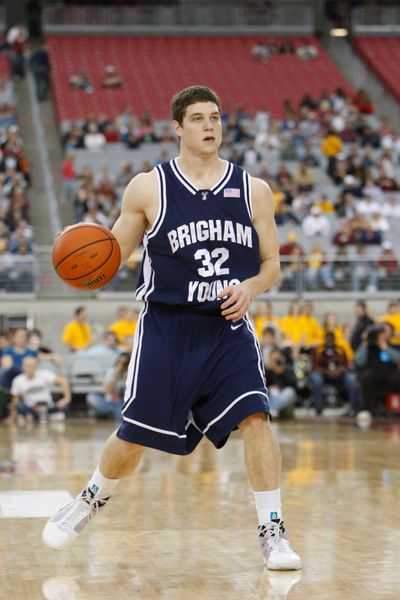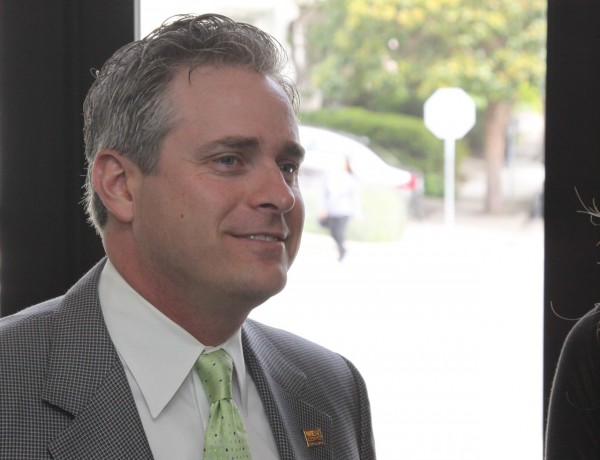Posted by rtmsf on August 31st, 2010
We asked two of our best contributors to take a look at today’s news that BYU has decided to go independent in football while joining the WCC in all other sports. As he’s done all summer, our Mountain West correspondent Andrew Murawa breaks down all the moving pieces here in a simple, understandable way. Additionally, our WCC correspondent, Michael Vernetti, stops by with a profile of the architect of the biggest coup of realignment summer, WCC Commissioner Jamie Zaninovich.
What Does It Mean? by Andrew Murawa
The wait for the next step in conference realignment is over, as BYU announced today its intention to forge ahead as an independent in football while joining up with the West Coast Conference in most other sports, beginning in 2011-12. In the process, the last hopes for the Western Athletic Conference to remain a viable entity have vanished, and the Mountain West Conference has turned its gaze from perhaps earning an automatic bid to the BCS for its conference champion to simple survival.

Jimmer Fredette Won't Get a Chance to Play in the WCC, but We Savor Future BYU-Gonzaga Matchups
A look at the news from the perspective of all the major entities in this move, BYU, the WAC, the MWC and the WCC:
- BYU – it appears all along that BYU was set on going independent in football, and just needed to find a soft landing spot for its other sports. In football, they’re working with ESPN on a deal for their television rights and they’ll make a viable schedule out of the remnants of the WAC (Utah State and Hawai’i are already on the schedule for 2011) and whoever else ESPN can convince to play them. Regardless, they’re certainly not getting a Notre Dame-style sweetheart deal from the BCS and they’ll likely have trouble filling out a schedule decent enough to regularly put them in BCS contention. As for the move to the WCC, this is an excellent destination for a good basketball program, putting the Cougars into a spot where they should be able to compete with Gonzaga for conference supremacy immediately. Given St. Mary’s steady rise, Portland’s continued improvement, Loyola Marymount’s potential and the success of schools like Pepperdine, San Diego and Santa Clara in the past, the Cougars will definitely find some worthwhile competition there. And given that every other school in the league is a religious institution, BYU at least has something in common with its new conference mates (never mind the fact that BYU has a student body of 33,000, while the biggest school in the WCC has an enrollment of less than 9,000). But, the big key for BYU is getting away from what they found to be a limiting television package in the MWC. Now, they’ll be able to make use of their state-of-the-art media center and use it as a nice carrot to make sure that they are able to reach an agreement with ESPN. And, given that the WCC already has a television deal in place with ESPN for basketball and will reportedly retain broadcast rights for games not aired by the WWL, this is likely a big upgrade in terms of the television package for BYU.
- WAC – goodbye. If BYU had agreed to join the WAC in its non-football sports, at least there would have been some reason for the continued existence of the conference, but now standing at six teams with schools like Hawai’i and Utah State already considering other options, this venerable conference is on its deathbed as it approaches its 50th birthday. Right now, about the only reason for the remaining schools to stick together is in the hopes of getting the $10 million in buyout money from Fresno State and Nevada, money over which there will clearly be an epic legal battle. WAC commissioner Karl Benson insists that Fresno State and Nevada will have to remain in the conference through 2011-12, but the schools so far beg to differ. With six remaining members, the conference still holds a claim on an automatic bid to the NCAA Tournament for a couple of years, but the defection of one more school (whether it be Utah State to the MWC or Hawai’i to independence) would be the final nail in the coffin.
- MWC – saved from extinction a few weeks back by Fresno State and Nevada’s agreement to join the conference, the MWC is certainly hurt by the loss of BYU but it was going to happen sooner or later anyway. The hope of an automatic bid for its conference football champion to the BCS is now a distant memory and the conference is left with its meager television deal with Versus, CBS College Sports and its own network, The Mtn., now minus the Salt Lake City market (the regional hub of the conference). In order for the conference to remain a viable entity for the future, it will need to fix its issues with its television contracts, but in the short term, it is still a strong league. However, given that the television contract is locked in until 2015-16, the conference may find itself having to fight off other suitors for some of its strongest members. TCU has already been mentioned as a possible target for the Big 12, and there has even been talk of a merger or some kind of alliance between the Mountain West and Conference USA (talk fueled by meetings between the two conferences in the days after the MWC added Fresno State and Nevada). Finally, there is the possibility that the MWC would be interested in adding more teams. They could certainly finish off the WAC by stealing Utah State (a move that would probably thrill Fresno State and Nevada because it would immediately end the $5 million buyout talk) and maybe even New Mexico State. There have been hopeful rumors of adding some of the western CUSA teams (Houston, Tulsa and UTEP, for example), but the MWC’s television deal probably precludes that, so it will be interesting to see what the next move is for a conference that was very recently thought to be a significant up-and-comer.
- WCC – first, you have to wonder what Gonzaga thinks of this. They’ve been the alpha dog in the conference for years as the school casting shadows on the rest of the league, and now, they’re potentially just another tiny school bouncing about in behemoth BYU’s wake. Certainly Gonzaga basketball isn’t going anywhere, but they’re no longer the program that can be immediately penciled in as the favorite in the conference every single year. Looking at it from the Zags’ perspective, the addition of BYU adds a couple more high-quality games during the conference season to bolster its strength of schedule and maintain a high RPI -– perhaps they don’t have to go so nuts with their non-conference schedule anymore. As for the conference as a whole, BYU’s presence in basketball is nothing but good -– more high-profile games, stronger schedules and a big new market. The league – now at nine teams with the addition of BYU – will go to a 16-game full home-and-home round robin schedule (although they’ll need to figure out the logistics of that, since there is no longer an easy way to schedule travel partners with an odd number of teams) and they’ll need to rearrange their conference tournament (tournament semifinals have been on Sunday and BYU will not play on Sundays). And there is even the potential for further expansion. Pacific had been considered for possible conference membership in 2008, and the Tigers would be a good fit along with the existing Bay Area schools (St. Mary’s, San Francisco, Santa Clara), but Denver and Seattle have also been mentioned as possible new invitees, given that those schools would add new large markets to the conference. Denver, in particular, would be a natural travel partner for BYU. All things considered, this is an exciting day for fans of schools all around the WCC, even if the size and particular religious affiliation of BYU may give brief pause.
What’s next?
Read the rest of this entry »
| rtc analysis
| Tagged: byu, craig thompson, denver seattle, fresno st, gonzaga, hawaii, houston, jamie zaninovich, jimmer fredette, karl benson, loyola marymount, mountain west, nevada, new mexico st, pacific, pepperdine, princeton, san diego, san francisco, santa clara, st mary's, tcu, tulsa, utah st, utep, wac, wcc
Share this story












































